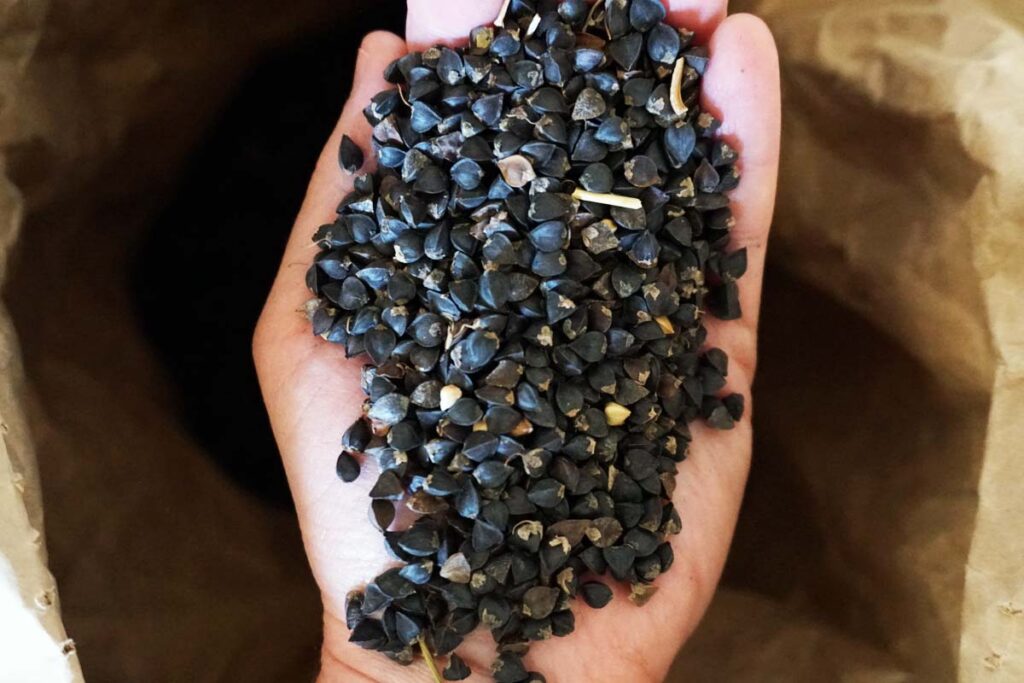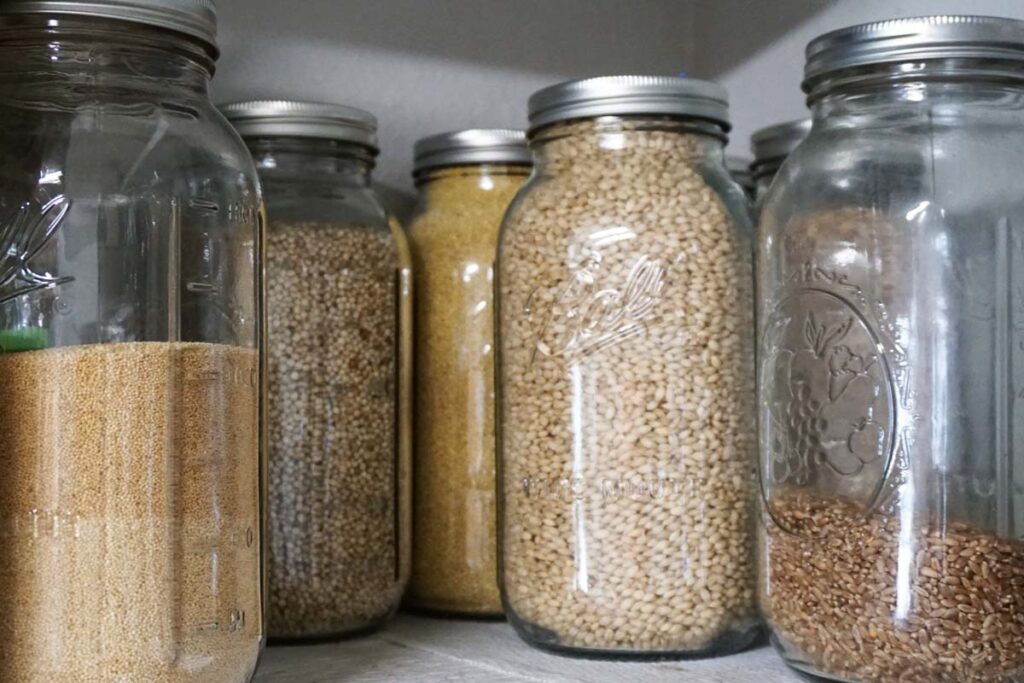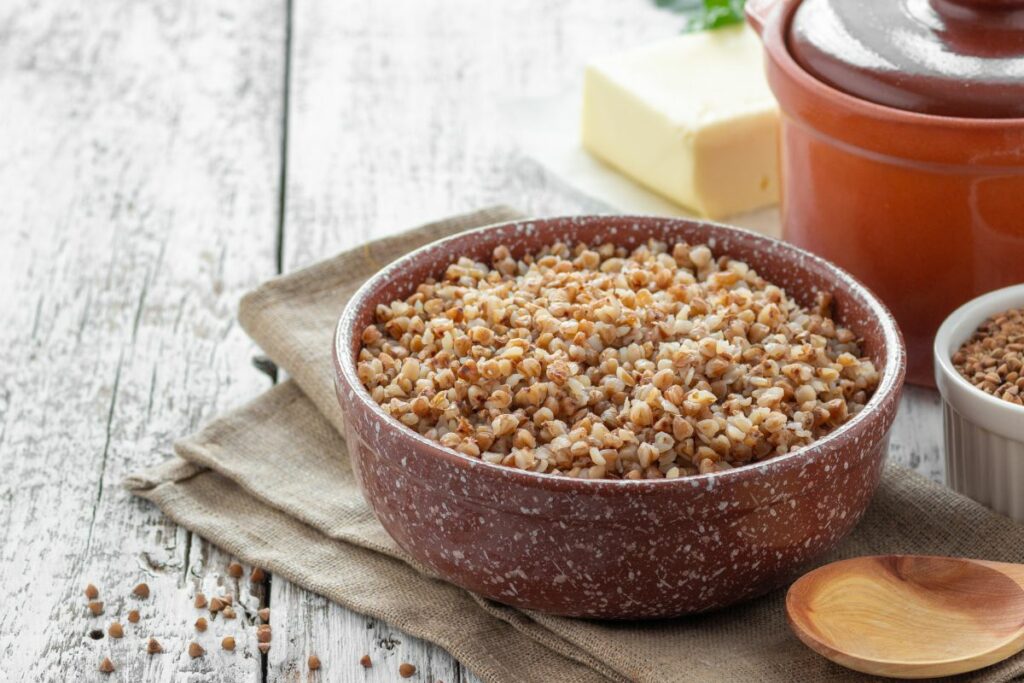Before I started exploring whole grains my only exposure to Buckwheat was in the form of Buckwheat pancakes (which are delicious!). Buckwheat is a staple in Russian, Ukrainian, and Japanese cuisines, and has been recently gaining popularity worldwide as gluten-free baking is becoming more mainstream.
What’s funny to me is that, despite its name, Buckwheat is not actually a wheat, it’s a pseudo-grain, which is a food that is consumed like a grain but isn’t one. It’s actually a fruit and in the same family as rhubarb.
But, there is a lot of nutritional punch in this pseudo-grain as its nutritional value is considerably higher than many traditional grains. Its high protein content and presence of essential minerals and antioxidants make it a great choice, so let’s dive in!
What is Buckwheat?
Buckwheat is a gluten-free alternative to wheat as it’s technically a seed that is triangular in shape and has a black hull.
Their light tan/green color resembles miniature versions of beech tree nuts or fruit. This is what led to its name … “buckwheat” … even though it’s not part of the cereal family. Instead it’s name is derived from the Dutch word “boekweit,” meaning “beech wheat.”
There are three main types of Buckwheat that you’ll come across when sourcing grains:
- Whole or un-hulled
- Hulled, which is raw and can be sprouted
- Kasha, which is toasted (cooked) and cannot be sprouted
Buckwheat is high in fiber and has an impressive amount of minerals, such as magnesium, manganese, phosphorus, potassium, copper, zinc, and iron. You’ll also find vitamins B6, niacin, thiamin, and folate, as well as high-quality protein.
Types of buckwheat

Whole (un-hulled)
Whole buckwheat still has its hull intact, is black in color, and is most often used for sprouting and to create Buckwheat flour. Whole Buckwheat is not typically cooked into a porridge (also generically called an “oatmeal” here in the United States) as the hull is too hard and it won’t have the right texture.
But, when a whole Buckwheat is ground into flour, its hull is what gives Buckwheat flour its unique flavor. Note that whole Buckwheat cannot be ground with a home mill typically used for wheat. You’ll need a steel grinder or some people use blenders to make flour.
Groats
Groats are the whole Buckwheat kernels that have had the black hull removed. They are light tan, almost green-ish in color. Most “Buckwheat” you find in stores are actually “Buckwheat groats.” Sometimes you can also find Buckwheat that has been cracked or ground into smaller pieces called “Buckwheat grits.”
Buckwheat groats can be sprouted and can also be ground into Buckwheat flour using a standard home mill.
Kasha
Buckwheat groats that have been toasted are called “Buckwheat kasha.” You can tell by the slightly darker color or “kasha” will be written on the packaging.
You can toast your own Buckwheat groats to make Buckwheat kasha to create a slightly stronger, nuttier flavor than un-toasted buckwheat. It also tends to hold its shape better when cooked.
It pairs well with darker spices, coffee, nuts, mushrooms, beets, figs, berries, cherries, and other strong flavors.
Nutritional profile of Buckwheat
A great source of protein, amino acids, vitamins and minerals, Buckwheat can offer your body key nutrients. In a 100 g (or 3.5 oz) serving of Buckwheat, you’ll find:
Amount | |
|---|---|
| Calories | 343 kcal |
| Carbohydrates | 71.5 g |
| – Dietary Fiber | 10 g |
| – Sugars | 0.9 g |
| Protein | 13.3 g |
| Fat | 3.4 g |
| – Saturated Fat | 0.7 g |
| – Monounsaturated Fat | 0.6 g |
| – Polyunsaturated Fat | 1.3 g |
| Omega-3 fatty acids | 0.1 g |
| Omega-6 fatty acids | 1.2 g |
| Vitamins & Minerals | |
| – Calcium | 18 mg |
| – Iron | 2.2 mg |
| – Magnesium | 231 mg |
| – Phosphorus | 347 mg |
| – Potassium | 460 mg |
| – Zinc | 2 mg |
| – Vitamin B6 | 0.3 mg |
| – Folate (Vitamin B9) | 30 μg |
| – Niacin (Vitamin B3) | 5.6 mg |
| – Pantothenic acid (Vitamin B5) | 0.9 mg |
| – Riboflavin (Vitamin B2) | 0.1 mg |
| – Thiamin (Vitamin B1) | 0.1 mg |
| – Vitamin E | 0.6 mg |
| – Vitamin K | 1.6 μg |
| – Vitamin C | 0 mg |
| – Vitamin A | 0 IU |
Vitamins and minerals
Buckwheat is rich in essential vitamins and minerals. It contains vital nutrients like copper, magnesium, iron, manganese, phosphorus, and zinc. As for vitamins, buckwheat is a great source of B vitamins, particularly niacin. All of these nutrients come together to make buckwheat a nutrition powerhouse.
Protein and amino acids
One thing that sets Buckwheat apart from other grains is its impressive protein content. It contains 13.3 grams of protein per 100 grams of raw buckwheat, which is higher than many other pseudograins. This protein is of high quality and boasts a diverse range of amino acids, which are essential building blocks for our muscles and other vital functions in our bodies.
When it comes to dietary fiber, Buckwheat doesn’t disappoint either. It provides us with 10 grams of fiber per 100 grams of raw buckwheat. This fiber can help with digestion, satiety, and even support heart health.
Health benefits of Buckwheat
- Blood sugar control: Buckwheat has a low glycemic index, which means that it doesn’t cause rapid spikes in blood sugar levels. Buckwheat is a better grain alternative for someone wanting to reduce glucose spikes.
- Heart health: Buckwheat contains rutin, a flavonoid that can help protect the heart and blood vessels, and other antioxidants like quercetin, which is known for its anti-inflammatory properties.
- Digestive health: A good source of fiber, which is essential for maintaining healthy digestion. Additionally, it contains resistant starch, a type of carbohydrate that isn’t broken down by our bodies, promoting good gut bacteria and supporting digestive health.
Cooking and baking with Buckwheat
Buckwheat is so much more than pancakes (although that is one of my favorite ways to enjoy it).
- Buckwheat flour: Buckwheat flour has an earthy and slightly nutty taste and works well for breads, tortillas, and yes, even pancakes. But it really shines as an addition to existing recipes you already love. Substitute up to 25% of wheat with Buckwheat as it lightens up baked goods to create more delicate pastries.
- Groats and Kasha: You can sprout Groats or incorporate them into salads for a nutritious and tasty crunch. Kasha works well in hot cereals or as a base for a hearty chili.
- Soba noodles: These Japanese noodles are made from a blend of buckwheat and wheat flours, giving them their unique texture and taste. They can be used in various ways, such as in soup or served cold with a dipping sauce.
Recipes
One of my go-to dishes using buckwheat is a simple salad with groats, fresh veggies, and a tangy dressing. I love that it’s easy to customize by adding my favorite ingredients or experimenting with different flavor combinations. Here are some other recipe ideas that showcase the versatility of buckwheat:
- Pancakes: Swap out traditional wheat flour for buckwheat flour
- Granola: Incorporate buckwheat groats into your granola recipe for added crunch and nutrients
- Breads and tortillas: Use buckwheat flour to make gluten-free breads and tortillas with a unique taste and texture
- Hot cereal: Cook kasha in a mixture of milk and water for a satisfying, gluten-free hot cereal
How to source and store Buckwheat
I’ve had some hits and misses when it comes to sourcing Buckwheat. Here are some tips:
- Gluten-free: If you have Celiac Disease, make sure you’re buying it with a clear “gluten-free” label as many mills share equipment with standard grains
- Know the type: It’s not always obvious what you’re buying. Make sure you are double-checking if you’re buying Whole Buckwheat (which is black), raw Hulled Buckwheat Groats (which are tan/green), Kasha (Roasted Buckwheat Groats), or Buckwheat Flour. Remember, you can’t grind Whole Buckwheat in a standard mill, so make sure to choose the one that fits best in your recipes
- Watch out for dirty grains: Some brands are better than others when it comes to the cleanliness of the grain. If it’s your first time buying from a specific company, buy a small bag first and see the quality of the grain before purchasing a large bag or bucket
- Check your local grocery stores: I have been pleasantly surprised that my local H-E-B (a Texas-based grocery chain) started carrying Buckwheat flour

Once you have your Buckwheat, storing it is fairly simple. Whole Buckwheat, Groats, or flour should be keep it in an airtight container in a cool, dry, and dark location. This ensures that it stays fresh for as long as possible.

I typically use 1-gallon mason jars to store my grains.
Frequently asked questions
What are the health benefits of buckwheat?
Buckwheat is a nutritious pseudo-grain that offers a range of health benefits. It’s rich in fiber, which helps with digestion, and contains all essential amino acids, making it a complete protein. It’s also a good source of antioxidants, vitamins, and minerals such as magnesium and manganese. Moreover, buckwheat is gluten-free, making it a suitable alternative for individuals with gluten sensitivities.
How can Buckwheat be incorporated into various recipes?
I love how versatile Buckwheat is in different recipes. You can use Buckwheat Groats as a base for salads, stir-fry dishes, and porridges. Toasted Buckwheat, or Kasha, works well as an ingredient in pilafs and casseroles. Buckwheat noodles, like Japanese soba, make for a delicious and gluten-free pasta dish. And, of course, Buckwheat flour can be utilized in various gluten-free baking recipes. You can also substitute up to 25% of a wheat flour in a recipe with Buckwheat flour to make it extra light, fluffy, and delicious!
Which gluten-free grains can be substituted for Buckwheat?
If you’re looking for alternatives to Buckwheat, there are other gluten-free grains available. Some options include quinoa, millet, brown rice, amaranth, and sorghum. Each grain has its unique flavor, texture, and nutritional profile, so experiment to find which one works best for your recipes and taste preferences.
Can you use Buckwheat flour in baking?
Yes, Buckwheat flour can be used in gluten-free baking. It imparts a distinct flavor and has a slightly heavier texture compared to wheat flour. You might need to adjust your recipe slightly, but it works well in pancakes, waffles, muffins, and even bread, although it needs to typically be combined with other grains to help with a good rise. I recommend combining Buckwheat flour with other gluten-free flours to achieve the desired consistency in your baked goods.
How does Buckwheat taste compared to other gluten-free grains?
Buckwheat has a unique earthy and nutty flavor, which is slightly stronger compared to other gluten-free grains. I find that its rustic taste complements savory dishes, while it can also be enjoyed in sweet recipes like puddings or granola bars. Toasting Buckwheat, or using the toasted version known as Kasha, can enhance its natural flavors.
What types of dishes work well with Buckwheat?
Buckwheat is a fantastic addition to a variety of dishes. I enjoy using it in simple salads with veggies and a tangy dressing, as well as in heartier meals like stir-fries and risotto-style dishes. Its nutty flavor pairs well with earthy ingredients like mushrooms and onions. In addition, buckwheat-based noodles make an excellent base for Asian-inspired dishes, like soba noodle salads, soups, or as an alternative to traditional pasta dishes.








